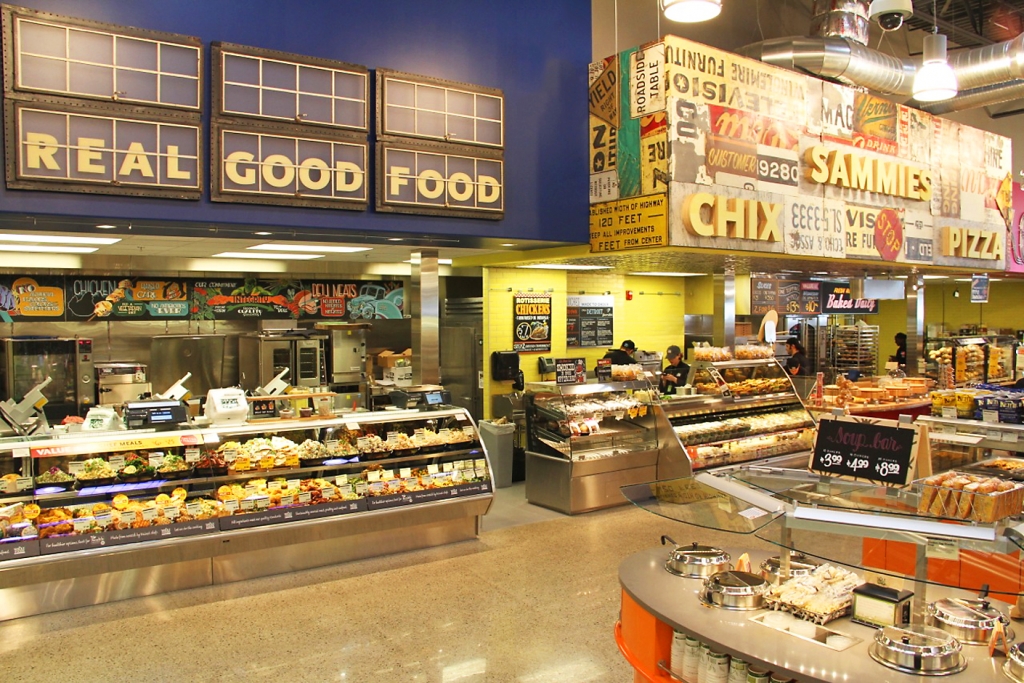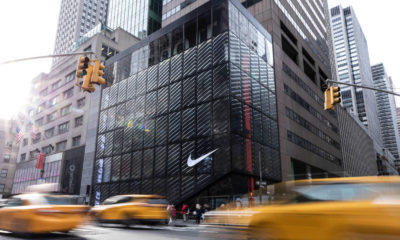BOPUS.
That five-letter acronym might be the future of supermarket retailing.
It stands for “Buy Online, Pick Up at the Store,” and it’s at least one of the scenarios for supermarkets remaining viable and coexisting with online retailing.
This hybrid approach would allow supermarkets to receive online orders and make them available to the customers who pick them up in the store. But how they set it up is the challenge. The fulfillment part is largely a back-room operational function. There’s still a store to be designed and laid out in an exciting and compelling way.
“We’ve told some of our supermarket clients to turn half their store into a fulfillment center and make the other half really cool,” says Lee Peterson, creative director at WD Partners (Columbus, Ohio). “Wall off the center of the store and fill the edges with things like kiosks for ordering prepared meals, specialty food offerings, tastings, cooking and entertaining lessons, places to sit and eat or drink coffee. In some states, you can even serve wine and beer in the store.”
After all, supermarkets already have such huge investments in real estate that it behooves them to give people a reason to visit the stores. Too often, that’s an uphill battle. “Some of our research says people are saying, ‘I love buying online, and I like the idea of picking it up at the store, but I just don’t want to go into the store,’ ” says Peterson. “Going to the supermarket is something people are no longer very excited about.”
Advertisement
In other words, the old notion that online food shopping is not viable because people want their commodities instantly and they want to be able to evaluate their produce and meats first-hand is fading.
“Right now, about 10 percent of all American consumers are buying at least some of their groceries online,” says Daniel Montaño, creative director at Little (Charlotte, N.C.), the global design firm with a history of supermarket work. “We just saw a presentation, ‘The Future Shock of Online Grocery Shopping – What you Need to Know,’ by Bricks Meets Clicks [the Barrington, Ill., research and consulting organization]. It said that by 2023, Americans will be spending as much as 17 percent of their total grocery dollars online.”
Nor is the challenge only from online commerce. Supermarkets are also facing an increasingly segmented food market. “Food retailing has become multi-tiered,” says Ken Nisch, chairman of JGA, the Southfield, Mich., design consultancy. “You have commodity providers, high-end providers, low-price providers, specialty foods providers, convenience providers and nutrition providers.”
Too many supermarkets are falling into the “commodity” bucket. Without a compelling in-store experience, they’re left with just a single strength: a wide selection of packaged goods, which an online retailer like Amazon could easily co-opt.
BOPUS could at least move supermarkets over to the “convenience” bucket. But to truly transform themselves, big supermarket chains have to answer the question: What in-store experience can I offer that all the online and physical grocery suppliers can’t?
The answer might be: information. For several years, Whole Foods Market (Austin, Texas) – the food retailer that added experience to the experience – has turned its stores into educational resources and social meeting places.
Advertisement
“People go to Whole Foods,” says Peterson. “They want to be there. It’s a destination.”
And they’re constantly innovating.
“On Fridays, they have what they call Five After Five,” Peterson says. “At 5 p.m., you can get a flight of five tasting-size glasses of wine for $5. And all the while, you’re walking through the store, sampling from chefs’ cooking stations and putting together a prepared meal to take home.”
Whole Foods has also been trying to relate to the distinct nature of its various communities, some of them far from the affluent suburbs or posh urban neighborhoods.
It recently opened a new store in downtown Detroit, a city struggling through bankruptcy that wouldn’t seem a great fit for a food store with a high-end reputation.
But the store has been created to meet specific local needs. “Downtown Detroit had been a food desert,” says JGA’s Nisch, whose firm designed the store. “There are no big chains or mainstream grocers there.”
Advertisement
The Whole Foods store is on Mack Avenue, in the midst of a neighborhood that includes the Wayne State University School of Medicine and The Detroit Medical Center, and it’s just two blocks from Wayne State’s main campus and the Tigers’ home baseball field at Comerica Park.
It’s also near Detroit’s extremely popular downtown farmers market, which draws people into the city center from all over the area. People who like the green grocer sensibility on the weekends can now go to Whole Foods all the time.
The location has many office workers and people from the school and medical center who pick up groceries or prepared meals on their way home, says Nisch. But the community is also filled with artists, educators, students and “urban pioneers” who feel Whole Foods is compatible with their lifestyle.
So the store was built with local materials from demolished buildings and scrap yards in the area and is filled with the work of local artists.
It’s all part of Whole Foods’ attempt to stand for something. Like Trader Joe’s, another successful and growing specialty retailer, Whole Foods connects with shoppers through the quality of its offering, the exotic nature of some of its merchandise, sophistication or just funkiness.
But mostly, it’s identifying special needs that the mass merchandisers couldn’t possibly meet. Little recently completed a new concept called The Baby Grocery Store in Charlotte, 6400 square feet devoted entirely to a special need: first-time parents who want to feel they’re doing the right things for their newborns. “It has a high-end selection of baby foods, but also toys, accessories and equipment,” says Montaño. “And it includes a kitchen area for testing recipes, informational classes, nursing rooms for mothers and all kinds of guides for people to use the new high-end specialized equipment they’ve just purchased.”
The emphasis, he says, is on “community” – shared situations and needs that draw people together for lactation consultations by local hospitals, baby massage classes, cloth diapering seminars, new product trunk shows and more.
Is the lesson here that traditional grocers should become baby care experts?
Not at all, says Little’s Montaño. “The lesson is that to stay relevant, supermarkets should consider creating unique products in niche categories to increase their ‘expert’ credentials. Customers come to expect curated products and information that is tailored to their particular needs.
“For years, supermarkets have tried to be something for everyone. Today’s shoppers don’t necessarily want that anymore. They are rejecting a one-size-fits-all approach.”


 Headlines7 days ago
Headlines7 days ago
 Headlines2 weeks ago
Headlines2 weeks ago
 Headlines2 weeks ago
Headlines2 weeks ago
 Headlines2 weeks ago
Headlines2 weeks ago
 John Ryan2 weeks ago
John Ryan2 weeks ago
 Sector Spotlight1 week ago
Sector Spotlight1 week ago
 Headlines2 weeks ago
Headlines2 weeks ago
 NEXT UX2 weeks ago
NEXT UX2 weeks ago





































